There is magic in finding a creature the size of a grain of rice hiding within the reef. Macro life is bizarre and intriguing and includes some of the ocean’s most elusive masters of disguise, as well as some of the most effective predators.
The Mergui Archipelago in Myanmar (Burma) is a veritable playground for macro enthusiasts. This vast area features over 800 islands and 3,000 islets, flanked by pristine reefs. The seascape’s many nooks and crannies set the stage for a 3-ring circus of crustaceans, pipefish, seahorses, frogfish, cowries and nudibranchs, just to name a few. There is so much macro life in the Mergui Archipelago, in fact, that we’ve broken our guide into two parts. This is the second — find our first round of macro magic here.
Pinecone fish (Monocentris japonica)
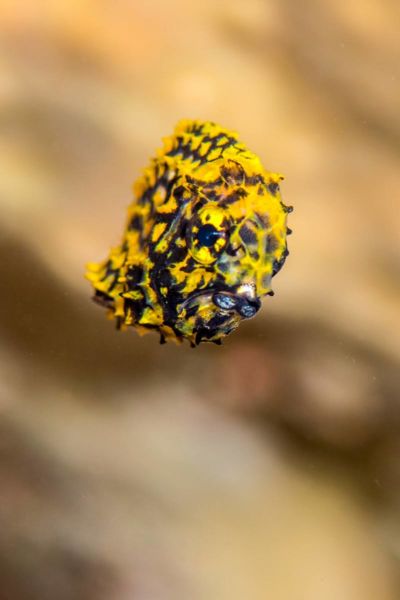 Like little medieval knights, pinecone or pineapple fish are covered in armor-like scales with a distinctive yellow and black pattern that gives them their name. Growing up to 6.7 inches (17 cm), they are nocturnal and have a special party trick for their midnight hunts. Their mouth, which is in a perpetual scowl, contains bioluminescent plankton which glows either green as juveniles or red as adults. Much like anglerfish, this little raver can control when the light comes on to lure in unsuspecting prey.
Like little medieval knights, pinecone or pineapple fish are covered in armor-like scales with a distinctive yellow and black pattern that gives them their name. Growing up to 6.7 inches (17 cm), they are nocturnal and have a special party trick for their midnight hunts. Their mouth, which is in a perpetual scowl, contains bioluminescent plankton which glows either green as juveniles or red as adults. Much like anglerfish, this little raver can control when the light comes on to lure in unsuspecting prey.
Complex marble shrimp (Saron marmoratus)
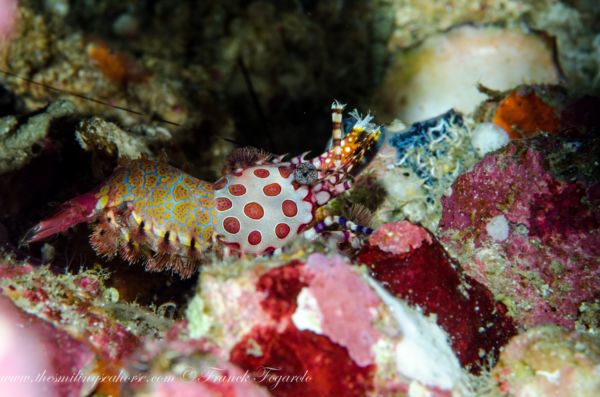 Also known as the tapestry shrimp, this shrimp looks like it’s dressed in several of your grandmother’s curtains all at once. Its flamboyant patterns, although mismatched, help it blend into its surroundings like many of its shrimp cousins. It is mainly nocturnal and will change colors to mostly red to blend in better in the dim twilight. Quite shy, they like to live in coral rubble and duck in quickly when they see a diver, which makes them quite hard to photograph. It is a scavenger that will forage for meaty morsels of plankton and other organic edibles forgotten in the debris.
Also known as the tapestry shrimp, this shrimp looks like it’s dressed in several of your grandmother’s curtains all at once. Its flamboyant patterns, although mismatched, help it blend into its surroundings like many of its shrimp cousins. It is mainly nocturnal and will change colors to mostly red to blend in better in the dim twilight. Quite shy, they like to live in coral rubble and duck in quickly when they see a diver, which makes them quite hard to photograph. It is a scavenger that will forage for meaty morsels of plankton and other organic edibles forgotten in the debris.
Peacock mantis shrimp (Odontodactylus scyllarus)
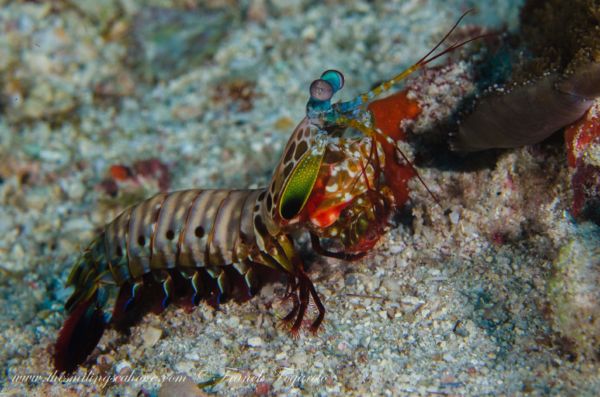 One of the heftier macro creatures in the Mergui Archipelago, the peacock mantis shrimp can grow up to 7 inches (18 cm) long. If Joseph’s Amazing Technicolor Dreamcoat came alive, it be this shrimp. Furthermore, these creatures have the capacity to perceive a much wider color spectrum than human eyes so we might not even be able to see the full extent of its psychedelic coloring. They also possess super strength, with the ability to punch as fast as a 22-caliber bullet travels. Even if they miss their mark and don’t make contact, the blow will boil the water instantly, creating a shockwave so strong it can be deadly to its prey.
One of the heftier macro creatures in the Mergui Archipelago, the peacock mantis shrimp can grow up to 7 inches (18 cm) long. If Joseph’s Amazing Technicolor Dreamcoat came alive, it be this shrimp. Furthermore, these creatures have the capacity to perceive a much wider color spectrum than human eyes so we might not even be able to see the full extent of its psychedelic coloring. They also possess super strength, with the ability to punch as fast as a 22-caliber bullet travels. Even if they miss their mark and don’t make contact, the blow will boil the water instantly, creating a shockwave so strong it can be deadly to its prey.
Spanish dancer nudibranch (Hexabranchus sanguineus) and the emperor shrimp (Periclimenes imperator)
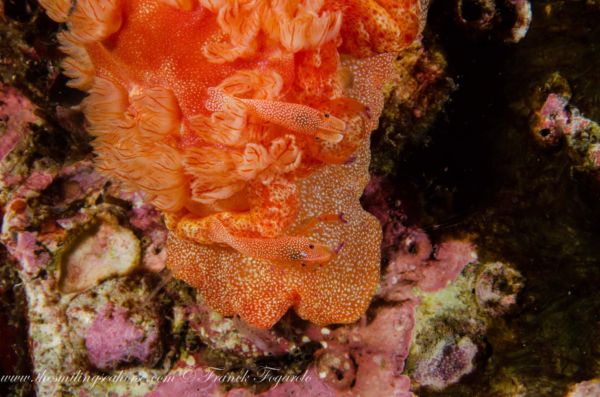 The Spanish dancer is probably one of the world’s most famous varieties of nudibranch. Usually between 8 to 16 inches (20 to 40 cm) long, Spanish Dancers can be seen at night either on the reef or sometimes even swimming. They also often feature a hitchhiker or two, the smaller-than-2 cm emperor shrimp. Although these shrimp are considered commensal, they actually have a mutualistic symbiosis with the nudibranch. The shrimp eats tidbits stirred up by the nudibranch and receives protection and a lazy way to travel around the reef. In return, it will clean up any parasites or debris from the nudi’s skin.
The Spanish dancer is probably one of the world’s most famous varieties of nudibranch. Usually between 8 to 16 inches (20 to 40 cm) long, Spanish Dancers can be seen at night either on the reef or sometimes even swimming. They also often feature a hitchhiker or two, the smaller-than-2 cm emperor shrimp. Although these shrimp are considered commensal, they actually have a mutualistic symbiosis with the nudibranch. The shrimp eats tidbits stirred up by the nudibranch and receives protection and a lazy way to travel around the reef. In return, it will clean up any parasites or debris from the nudi’s skin.
So many nudibranchs
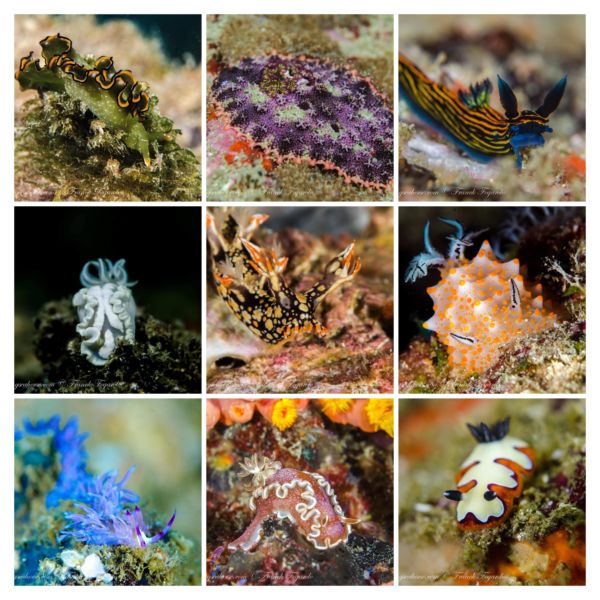 Too numerous to name, the Mergui Archipelago is bursting with these colorful mollusks. The region’s 3,000 species of confirmed nudibranchs, which range from .15 to 23 inches (4 mm to 60 cm), get their name from their exposed lungs. Depending on the species they may have either branchial plumes or cerata on their backs to breathe. They also have adorable little horn-like protrusions on their heads called rhinophores, which are their main sensory organ. A rainbow of colors, they are mimicry experts, adopting the coloration of their habitat and also warning potential predators of their toxicity. Very creative with self-defense, some even ingest the stinging cells of jellyfish and display them on their backs.
Too numerous to name, the Mergui Archipelago is bursting with these colorful mollusks. The region’s 3,000 species of confirmed nudibranchs, which range from .15 to 23 inches (4 mm to 60 cm), get their name from their exposed lungs. Depending on the species they may have either branchial plumes or cerata on their backs to breathe. They also have adorable little horn-like protrusions on their heads called rhinophores, which are their main sensory organ. A rainbow of colors, they are mimicry experts, adopting the coloration of their habitat and also warning potential predators of their toxicity. Very creative with self-defense, some even ingest the stinging cells of jellyfish and display them on their backs.
Tiger egg cowrie (Cuspivolva tigris)
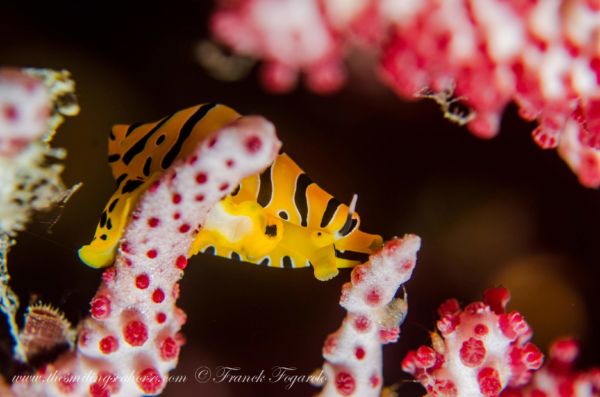 You can find this carnivorous mollusk munching away on gorgonian sea fans and other soft corals below 65 feet (20 m). They can grow up to .6 inches (1.5 cm) long and have a magnificent patterned shell resembling a tiger’s stripes. Like other cowries, there is a small gap on one side of the shell where you can see and orangey-yellow foot spotted with black. These are few and far between and a real treat to find when you can spot them.
You can find this carnivorous mollusk munching away on gorgonian sea fans and other soft corals below 65 feet (20 m). They can grow up to .6 inches (1.5 cm) long and have a magnificent patterned shell resembling a tiger’s stripes. Like other cowries, there is a small gap on one side of the shell where you can see and orangey-yellow foot spotted with black. These are few and far between and a real treat to find when you can spot them.
Pygmy squid (Idiosepius notoides)
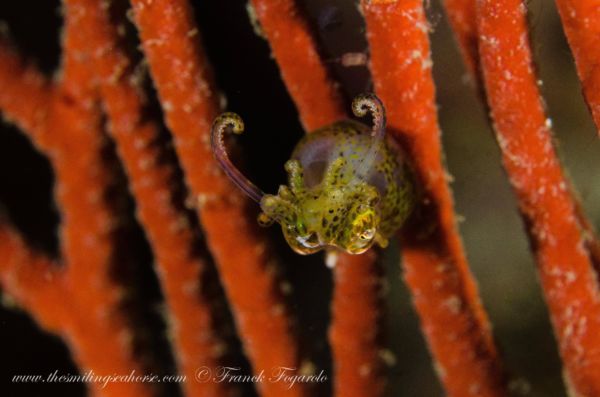 Pygmy squid are impossibly adorable. Reaching only .4 inches (1 cm) long, it’s easy to confuse these teeny tiny cephalopods with baby squid. They have a special gland on their underside that allows them to stick to the underside of seagrasses to wait for unsuspecting prey. Pygmy squid mostly eat very small crabs and shrimp but are sometimes brave enough to try to eat crustaceans nearly as big as themselves. They will sneak up on their prey from behind and bite through its nerve cord so that it can no longer move or try to flee.
Pygmy squid are impossibly adorable. Reaching only .4 inches (1 cm) long, it’s easy to confuse these teeny tiny cephalopods with baby squid. They have a special gland on their underside that allows them to stick to the underside of seagrasses to wait for unsuspecting prey. Pygmy squid mostly eat very small crabs and shrimp but are sometimes brave enough to try to eat crustaceans nearly as big as themselves. They will sneak up on their prey from behind and bite through its nerve cord so that it can no longer move or try to flee.
Seamoth (Pegasidae)
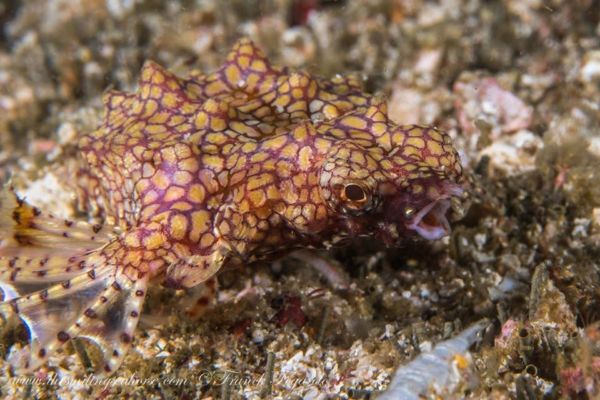 Seamoths usually crawl along the sandy sea floor with their adapted pectoral fins, searching for food. These wing-like pectoral fins can also fan out to help the animal move more quickly and fly over the sea floor or to try and scare off predators. They have no teeth but instead make a sort of tube out of their mouths to suck tiny invertebrates and worms up out of the sand and through their snout. They often travel in pairs and shed their bony, textured skin every few days to rid themselves of parasites.
Seamoths usually crawl along the sandy sea floor with their adapted pectoral fins, searching for food. These wing-like pectoral fins can also fan out to help the animal move more quickly and fly over the sea floor or to try and scare off predators. They have no teeth but instead make a sort of tube out of their mouths to suck tiny invertebrates and worms up out of the sand and through their snout. They often travel in pairs and shed their bony, textured skin every few days to rid themselves of parasites.
Frogfish (Antennariidae order Lophiiformes)
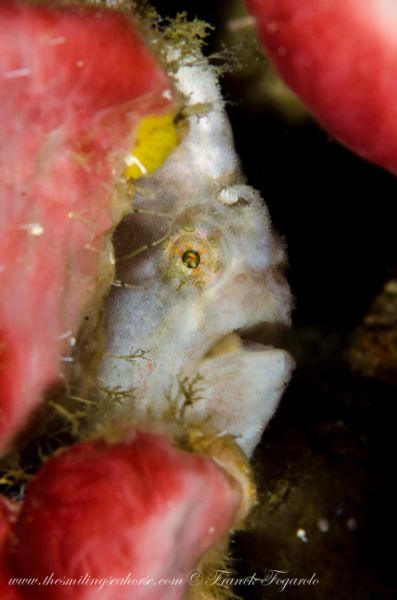 Frogfish belong to a family of anglerfish that includes over 50 unique members. These grumpy little lumps can range from 1 to 15 inches long (2.5 to 38 cm) with huge variations in color and texture. They will always match their appearance to their habitat of choice and sometimes even have a layer of hydrozoa or algae growing on them. They have flat pectoral fins that allow them to crawl across the reef since they aren’t very good swimmers. As an anglerfish, they have an illicium or “rod” that grows in the place of dorsal fins. The rod’s shape mimics their prey’s favorite snack to lure them in unsuspectingly.
Frogfish belong to a family of anglerfish that includes over 50 unique members. These grumpy little lumps can range from 1 to 15 inches long (2.5 to 38 cm) with huge variations in color and texture. They will always match their appearance to their habitat of choice and sometimes even have a layer of hydrozoa or algae growing on them. They have flat pectoral fins that allow them to crawl across the reef since they aren’t very good swimmers. As an anglerfish, they have an illicium or “rod” that grows in the place of dorsal fins. The rod’s shape mimics their prey’s favorite snack to lure them in unsuspectingly.
Shaded batfish (Platax pinnatus)
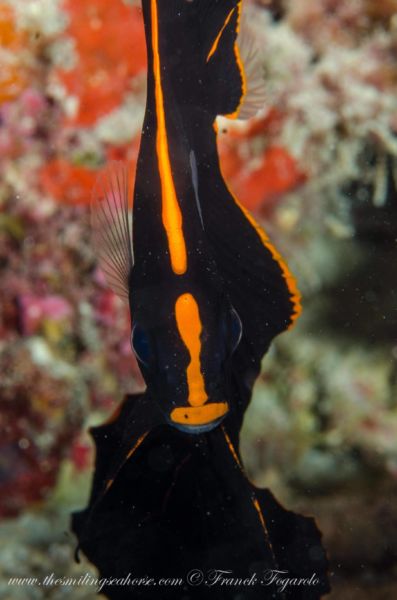 The shaded batfish, also known as pinnate spadefish, have a special symbiosis with the reef, as one no other type of fish eats one of their favorite seaweeds to snack on, which gives them sole responsibility for controlling its growth. The juvenile, as pictured, is one of our favorite types of fish to search for on a night dive. At this stage of life, they are boomerang-shaped, with their fins appearing much longer relative to their body size than as adults. They are inky black with a single orange line running along the edge of their body. This coloring deters predators by mimicking a specific type of poisonous flatworm.
The shaded batfish, also known as pinnate spadefish, have a special symbiosis with the reef, as one no other type of fish eats one of their favorite seaweeds to snack on, which gives them sole responsibility for controlling its growth. The juvenile, as pictured, is one of our favorite types of fish to search for on a night dive. At this stage of life, they are boomerang-shaped, with their fins appearing much longer relative to their body size than as adults. They are inky black with a single orange line running along the edge of their body. This coloring deters predators by mimicking a specific type of poisonous flatworm.
The Mergui Archipelago is a paradise for macro enthusiasts but also has a lot of larger visitors, such as oceanic manta rays and whale sharks. But that’s the topic of another article.
AUTHOR CAMILLE FOGAROLO AND HER HUSBAND FRANCK OWN THE MV SMILING SEAHORSE LIVEABOARD, THE NEWEST DIVE BOAT IN THE AREA. ALL IMAGES COURTESY FRANCK FOGAROLO.
Share this:
Camille Fogarolo / About Author
Camille has been traveling the world since her mid twenties and dived many seas before finally settling down in Thailand in 2012. With her husband Franck, they opened The Smiling Seahorse liveaboard to offer cruises in the most unexplored area of South East Asia and became quite the experts when it comes to diving in Myanmar! Proud mother of two she still travels as much as she can and usually joins a dive trip to Mergui Archipelago every month.
The famed Jacques-Yves Cousteau referred to Cabo San Lucas as “the aquarium of the world.” Uniquely situated between the Sea of Cortez and the Pacific Ocean, the competing climates and conditions of these two powerful bodies of water make diving Cabo San Lucas truly extraordinary.
Today, Cabo proudly holds the No. 2 spot on Mexico’s list of top travel destinations, second only to Cancun. The scuba community has long known about Cabo’s delights, and the region offers sites suitable for all levels. The climate is tropical desert, with hot and humid summers and fall months. Slightly cooler, crisper temperatures follow for the rest of the year.
Diving Cabo San Lucas
Although you can conveniently reach many dive sites from shore, diving by boat is most common. There are several local dive operators, all downtown on the marina. Once you book, meet your operator at their shop; rent gear if necessary; meet your divemaster and crew; and head down to the dock. If you’re diving Cabo San Lucas (CSL) Marine Park, you’ll enjoy a short 10-minute boat ride before you reach one of the many dive sites. Here are a few of our favorites.
Pelican Rock
This novice-to-advanced site is located on the west side of the CSL Marine Park. Divers will immediately notice a large rock approximately 300 feet (91 m) offshore. As the most accessible dive site, popular Pelican Rock sees hundreds of tourists daily. The rock is surrounded by sand at a depth of 20 feet (6 m), but if you continue to the north side of the rock, a beautiful reef emerges. It continues until it meets the main wall at a depth of 80 to 100 feet (24 to 30 m), where it plunges into a submarine canyon, hundreds of feet deep.
You’ll see a wide variety of schooling fish here, including snappers, jacks, Moorish idols and even a group of whitetip reef sharks that move in during the summer months. Pelican Rock is also home to the famous sand falls, where you can watch as sand from the shelf plunges over a ledge into the abyss, like an underwater waterfall.
North Wall
North Wall is the closest site to the Cabo San Lucas Marina, which also means it’s the most protected dive site of those within the Marine Park. The site begins on a sandy slope in 10 feet (3 m) of water and slopes down to the start of a rocky wall at 25 feet (7 m). The wall consists of primarily small- to medium-sized boulders, creating endless hiding places for animals such as banded guitarfish, scorpionfish, moray eels, and whitetip reef sharks.
Land’s End
Land’s End is good for divers from beginners to advanced and includes both a seal colony and a wreck. The sea lions are accustomed to sharing their underwater world with divers and often come in close, blowing bubbles and seeing what the tourists are up to. As you make your way toward Land’s End from the colony, you will encounter a large pinnacle, barely breaching the surface, which extends down to the seafloor at 75 feet (22 m).
If you’re beginning the dive from the Pacific side of Land’s End, you will descend directly over the remains of an unnamed shipwreck, uncovered several years ago during Hurricane Odile and now scattered across an area the size of a football field. This is one of those bucket list sites that all divers should experience, as you never know what you’ll find. Schooling fish, sea lions, mobula rays — maybe even humpback whales.
Neptune’s Finger
Locating Neptune’s Finger is easy — just look for the large spire jutting out of the water to the East of Lover’s Beach and drop anchor in front. There is a sand flat at 18 feet (5 m), which leads down to several large, rocky outcroppings ranging from 40 feet to 100 feet down (12 to 30 m).
Here, the sloping, sandy bottom meets a sheer wall dropping down hundreds of feet. Typically known as an advanced dive site, divers in the know will spend up to half their dive out in the blue away from the wall, hoping for a magical pelagic encounter. Neptune’s Finger often features large pelagics, such as mobula rays, sea turtles, tuna and occasionally whale sharks.
What animals can you see?
The waters of Cabo are truly diverse. Year-round sightings include sea lions, olive ridley sea turtles, whitetip reef sharks, moray eels, eagle and manta rays, and plethora of reef and pelagic fish.
From December to May the bigger marine mammals appear in the area. These include humpback whales, orcas, schooling mobula rays, blue whales, and even whale sharks. Some dive shops will take you on an open-ocean expedition looking for mako sharks, blue sharks, marlin, turtles, and other pelagic marine life.
When to Go
September to November offers the best diving conditions. During these months, visibility is often over 60 feet (18 m). Water temperatures soar into the low 80s F (26 C). December through May brings in cooler waters, hence the bigger marine mammals that take up winter residence.
How to get there
Cabo sits at the end of Mexico’s Baja California Sur peninsula. Together with its sister city, San Jose del Cabo, located 32 miles (19 kilometers) north, the two cities form the Los Cabos municipality. You can reach Cabo both by air and land. Fly into San Jose del Cabo airport (SJD) and hail a taxi or rent a car for the roughly 30-minute drive south. If you’re up for a road trip, you can also drive from San Diego, California. Cross the border into Tijuana and enjoy a winding trip through Baja, roughly two days’ drive.
Share this:
Jacques Cousteau once claimed that the Poor Knights Islands have the best subtropical diving in the world. Although his geography was a little off — the Poor Knights Islands are located in a temperate zone — his confusion is understandable. Washed by a warm, tropical current, the waters abound with subtropical species, making scuba diving Poor Knights Islands one of the most unique dive experiences on the planet.
The Poor Knights Islands are New Zealand’s most famous dive destination. Located north of Auckland, off the small coastal town of Tutukaka, the Poor Knights Islands are bathed by the warm, clear waters of the East Australian Current (EAC), made famous in the film Finding Nemo. These warm waters bring subtropical species to the islands, which swim alongside temperate species in the kelp and sponge gardens around the islands. Because of this fascinating mix of species, the islands were declared a marine reserve in 1981.
Scuba diving Poor Knights Islands
I recently spent a week diving the Poor Knights Islands with Dive! Tutukaka. The islands are located 15 miles (24 km) offshore, so it takes around an hour to reach the dive sites. The crossing was never boring, with dolphins, seabirds, penguins and hammerhead sharks all making an appearance. The crew frequently sees sunfish, manta rays, seals, whales and orcas as well.
The terrain around the islands is breathtaking, featuring towering sea cliffs, caves, arches and rocky pinnacles. And most of these structures continue underwater, creating spectacular terrain. Each day I did two dives, and quickly found that most dive sites had options for beginners as well as more experienced divers.
Dive sites
Northern Arch — as you’d expect — features an impressive arch cutting through a rocky point. The bottom of the arch is at 125 feet (38 m), and the walls around it drop into 160 feet (50 m) or more. However, you needn’t go below 65 feet (20 m) to have a great dive. This amazing arch is overloaded with fish life, including snapper, kingfish and trevally, plus dense schools of very pretty pink and blue maomao. The dazzling walls of the arch are encrusted with colorful sponges, anemones, algae and bryozoans. One dive at this site featured a bronze whaler shark, a species often seen in deeper water.
We also dove at Middle Arch and Blue Maomao Arch, explored caves at Shark Fin Cave and Jan’s Tunnel, and investigated rocky, kelp-covered reefs and walls at Brady’s Corner, Magic Wall, Cleanerfish Bay and Dutch Cove.
Marine life
Each dive featured a variety of invertebrates — nudibranchs were especially common — and lots of friendly fish. Some species, common on the east coast of Australia, have different names here. The banded morwong is called the red moki and the eastern king wrasse is called the Sandager’s wrasse. But many of the fish are unique to this area, like cute little triplefins, perch and demoiselle. Temperate species like leatherjackets (filefish) and butterfly perch swim alongside subtropical species like the Lord Howe Island butterflyfish and the sharpnose puffer (black-saddled toby). Boarfish, scorpionfish, blennies, conger eels, butterflyfish and eagle rays were also on hand.
Stingrays are also very common at the Poor Knights Islands. Most dives featured smooth stingrays, known locally as the short-tailed stingray. At Cleanerfish Bay we found a cave with four huge stingrays, which also commonly gather in arches and caves over the summer months for breeding.
Even more impressive were the abundant moray eels. Most morays reside in tropical and subtropical regions but, surprisingly, seven species inhabit the Poor Knights Islands. I have never dived sites with so many morays, and not just hidden away in ledges, but out in the open and even draped over the kelp and sponges.
When to go
February — late summer in New Zealand — features pleasant water temperatures of around 70 F (21 C), but over the winter months it can drop to 60 F (16 C). Visibility typically varies from 40 feet (12 m) to 80 feet (25 m), but when the EAC pushes in, viz can top 100 feet (30 m).
The Poor Knights Islands are an incredible destination for underwater photographers, for either wide-angle or a closeup shots. The colors of the boulders are unforgettable, a rich tapestry of pinks, yellows, oranges, greens, reds and blues. On every dive my camera went into overdrive photographing the fish, morays, nudibranchs, stingrays and incredible structures. Diving in the Poor Knights Islands it’s easy to understand why Jacques Cousteau thought he was diving a subtropical paradise.
Share this:
Nigel Marsh / About Author
Nigel Marsh is an Australian underwater photographer and photojournalist whose work has been published extensively in magazines, blogs, newspapers and books. Nigel has been diving and taking underwater photos for almost forty years, and he has a great passion for marine life and travel. He has also authored over a dozen books, including dive guides to Australia, children’s books and marine life guides. For more information visit his website – www.nigelmarshphotography.com
There are generally two types of divers when it comes to marine life: those who favor the big stuff, and those who hunt for macro animals. Divers who seek the small stuff take pride in their keen eyesight and attention to detail and prefer to dive slowly with their mask mere inches from corals and sponge. Macro life is bizarre and intriguing and includes some of the ocean’s most elusive masters of disguise, as well as some of the most effective predators.
Macro life in the Mergui Archipelago
The Mergui Archipelago in Myanmar (Burma) is a veritable playground for macro enthusiasts. This vast area features over 800 islands and 3,000 islets, flanked by pristine reefs. The seascape’s many nooks and crannies set the stage for a 3-ring circus of crustaceans, pipefish, seahorses, frogfish, cowries and nudibranchs, just to name a few. There is so much macro life in the Mergui Archipelago, in fact, that we’ve broken our guide into two parts, starting with this one.
Harlequin shrimp (Hymenocera picta)
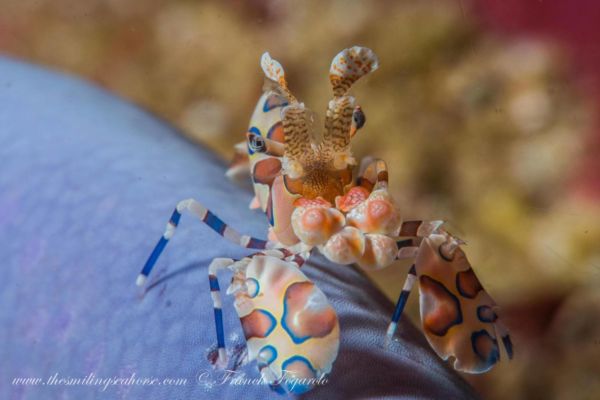 Harlequin shrimp usually live in pairs and are thought to mate for life, hunting and defending their territory together. These relatively shy shrimp tend to choose enclosed, dark areas and stay close to home. They are gruesome hunters, feeding exclusively on starfish — including the destructive crown of thorns, which can be up to 100 times larger than the shrimp in both size and weight. A mating pair will hunt down their prey, flip it onto its back and drag it back to their lair to eat starting with the tube-like feet on its underside. They are even known to force-feed the echinoderm to keep it alive and fresh while they feast.
Harlequin shrimp usually live in pairs and are thought to mate for life, hunting and defending their territory together. These relatively shy shrimp tend to choose enclosed, dark areas and stay close to home. They are gruesome hunters, feeding exclusively on starfish — including the destructive crown of thorns, which can be up to 100 times larger than the shrimp in both size and weight. A mating pair will hunt down their prey, flip it onto its back and drag it back to their lair to eat starting with the tube-like feet on its underside. They are even known to force-feed the echinoderm to keep it alive and fresh while they feast.
Orangutan crab (Achaeus japonicus)
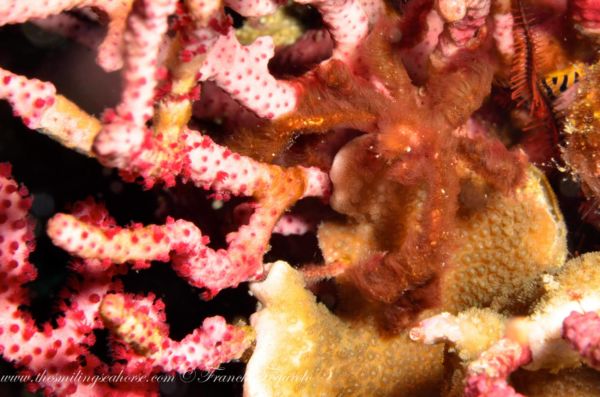 These fuzzy little guys have small bodies and long arms that are completely covered in dense reddish-brown hairs. Part of a family known as decorator crabs, they comb the seabed and reef looking for small bits of shells, gravel, and debris to lodge into their fur to help blend in. They are very clever and have been studied in different environments where they always select decorations based on what will camouflage best in their particular surroundings. Find them hiding in bubble coral during the day and hunting the seafloor at night.
These fuzzy little guys have small bodies and long arms that are completely covered in dense reddish-brown hairs. Part of a family known as decorator crabs, they comb the seabed and reef looking for small bits of shells, gravel, and debris to lodge into their fur to help blend in. They are very clever and have been studied in different environments where they always select decorations based on what will camouflage best in their particular surroundings. Find them hiding in bubble coral during the day and hunting the seafloor at night.
Candy crab (Hoplophrys oatesi)
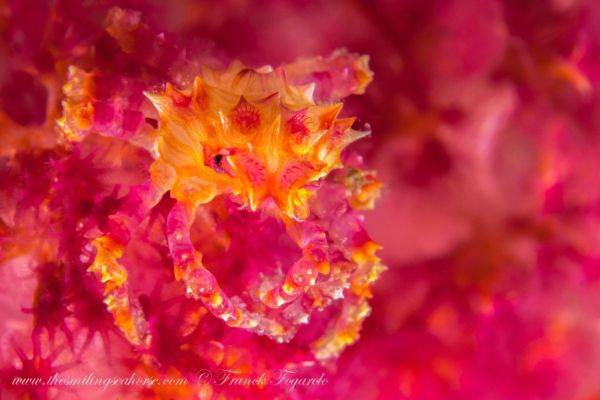 Another breathtaking marine curiosity, this crab’s appearance is reminiscent of something you would see in a Japanese anime cartoon. With a vibrant pink body, it mimics the colors and textures of the soft corals it takes refuge in. Growing to a maximum of ¾ inch (2 cm), its legs and carapace are covered in vivid spiny tubercles, which can vary in color depending on its habitat. It is also known to attach polyps to itself to further increase its camouflage.
Another breathtaking marine curiosity, this crab’s appearance is reminiscent of something you would see in a Japanese anime cartoon. With a vibrant pink body, it mimics the colors and textures of the soft corals it takes refuge in. Growing to a maximum of ¾ inch (2 cm), its legs and carapace are covered in vivid spiny tubercles, which can vary in color depending on its habitat. It is also known to attach polyps to itself to further increase its camouflage.
Skeleton shrimp (Caprellidae)
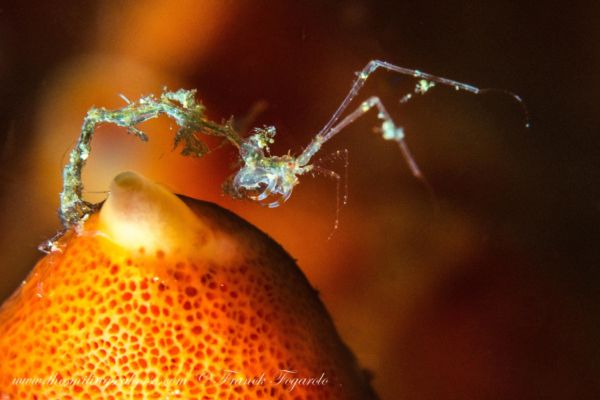 Skeleton shrimp are such a bizarre-looking crustaceans that it’s hard to believe that Tim Burton didn’t dream them up. They can grow up to ¾ to a little over one inch (2 to 3 cm) long but, unlike many marine species, the males are usually significantly larger than the females. Wiry and transparent, they have many legs that each have a specific purpose. The front legs are tipped with tiny claws for defense and feeding but they also use these to drag themselves along.
Skeleton shrimp are such a bizarre-looking crustaceans that it’s hard to believe that Tim Burton didn’t dream them up. They can grow up to ¾ to a little over one inch (2 to 3 cm) long but, unlike many marine species, the males are usually significantly larger than the females. Wiry and transparent, they have many legs that each have a specific purpose. The front legs are tipped with tiny claws for defense and feeding but they also use these to drag themselves along.
Xeno Crab (Xenocarcinus tuberculatus)
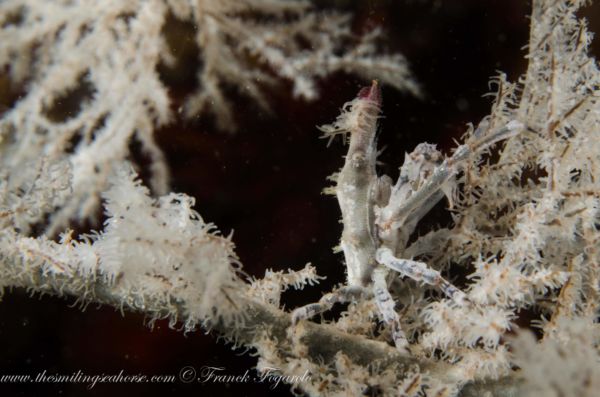 These tiny crabs rely on their home for camouflage. Their coloring will often depend on the coloring of the black coral or sea whip that they live in symbiosis with. They sometimes use algae or even the polyps of their host to decorate their carapace for even more discreet blending. Growing up to ¾ inch (2 cm) long, the xeno crab feeds on microalgae and small fish. They are normally solitary however, when they are young, they have been known to hang out with a buddy.
These tiny crabs rely on their home for camouflage. Their coloring will often depend on the coloring of the black coral or sea whip that they live in symbiosis with. They sometimes use algae or even the polyps of their host to decorate their carapace for even more discreet blending. Growing up to ¾ inch (2 cm) long, the xeno crab feeds on microalgae and small fish. They are normally solitary however, when they are young, they have been known to hang out with a buddy.
Orange-spotted pipefish (Corythoichthys ocellatus)
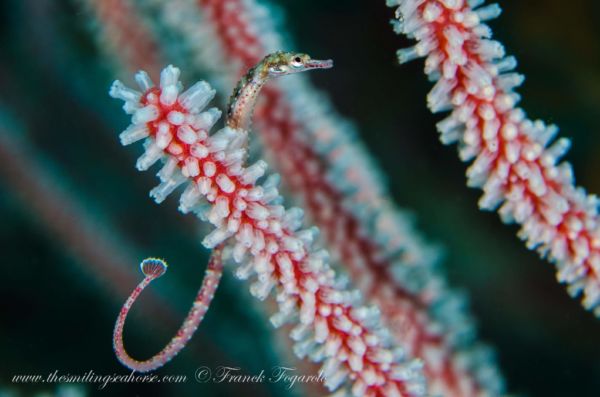 This adorable pipefish grows to between 3 and 4 inches (8 and 11 cm) long. They have a long snout and a pale body with orange and white markings. These shy animals prefer to live in areas shallower than 39 feet (12 m) on sandy bottoms or in small crevices and caves and often retreat to more sheltered areas as divers approach. Like the seahorse, the male orange-spotted pipefish will carry 200 to 400 fertilized eggs that the female deposits into his brood pouch to incubate for 14 to 17 days before they hatch.
This adorable pipefish grows to between 3 and 4 inches (8 and 11 cm) long. They have a long snout and a pale body with orange and white markings. These shy animals prefer to live in areas shallower than 39 feet (12 m) on sandy bottoms or in small crevices and caves and often retreat to more sheltered areas as divers approach. Like the seahorse, the male orange-spotted pipefish will carry 200 to 400 fertilized eggs that the female deposits into his brood pouch to incubate for 14 to 17 days before they hatch.
Bent-stick pipefish (Trachyrhamphus bicoarctatus)
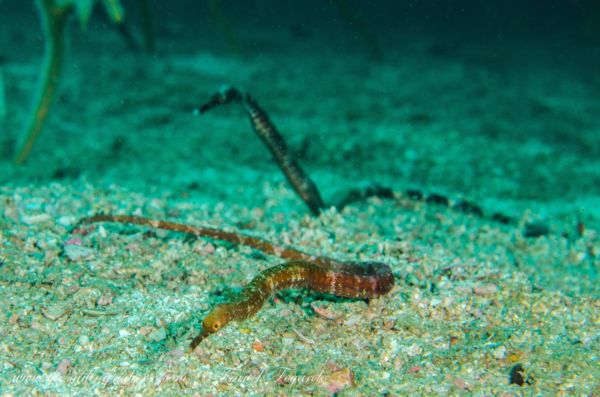 This intriguing creature, also called a double-ended pipefish, prefers to live in sandy seabeds up to 130 feet (40 m) deep. They often travel in pairs, sitting with their heads raised into the current to feed on drifting zooplankton. Reaching a length of 15 inches (40 cm), their bodies are long and slender with a small head that resembles a seahorse. They are a bit thicker around the middle and they use this area, along with the ventral caudal fin, to grab onto the sand and resist the water movement. Their back legs form a kind of stalk that helps them grip whichever substrate they perch on for feeding. They can vary in color depending on where they live, but we often see shades of black and brown in Myanmar.
This intriguing creature, also called a double-ended pipefish, prefers to live in sandy seabeds up to 130 feet (40 m) deep. They often travel in pairs, sitting with their heads raised into the current to feed on drifting zooplankton. Reaching a length of 15 inches (40 cm), their bodies are long and slender with a small head that resembles a seahorse. They are a bit thicker around the middle and they use this area, along with the ventral caudal fin, to grab onto the sand and resist the water movement. Their back legs form a kind of stalk that helps them grip whichever substrate they perch on for feeding. They can vary in color depending on where they live, but we often see shades of black and brown in Myanmar.
Ornate ghost pipefish (Solenostomus paradoxus)
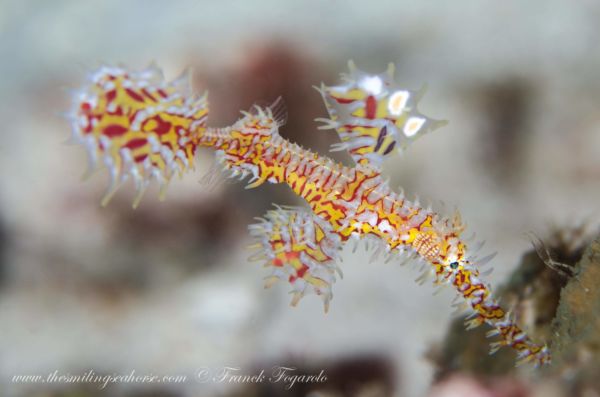 Arguably one of the most difficult macro critters to spot on the reef, this type of pipefish grows to only 4.7 inches (12 cm) and is a master of disguise. Although we know little about them, it is suspected that they spend most of their lives drifting in the current in a larval state and only settle on the reef to find a mate. The female is usually larger than the male and will die shortly after giving birth. They hover face down and adopt distinguishable red, orange or yellow markings that help them blend in quite effectively with their new home.
Arguably one of the most difficult macro critters to spot on the reef, this type of pipefish grows to only 4.7 inches (12 cm) and is a master of disguise. Although we know little about them, it is suspected that they spend most of their lives drifting in the current in a larval state and only settle on the reef to find a mate. The female is usually larger than the male and will die shortly after giving birth. They hover face down and adopt distinguishable red, orange or yellow markings that help them blend in quite effectively with their new home.
Tiger tail seahorse (Hippocampus Comes)
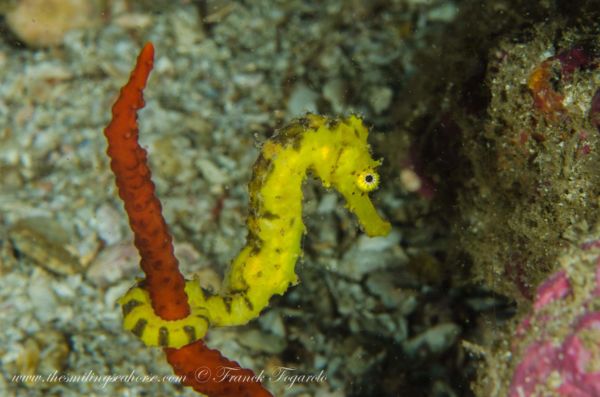 The tiger tail seahorse is an adorable specimen usually living in monogamous pairs. They occur in different color patterns and textures that can change for camouflage. More often than not, however, they are yellow with black stripes on their tail, which inspires their name. They will live on average 1.5 years, growing up to 7.3 inches (18.7 cm) and usually stick to the same sponge or kelp. They feed on tiny crabs, clams and shrimp but they have no teeth or stomach, so they feed via suction.
The tiger tail seahorse is an adorable specimen usually living in monogamous pairs. They occur in different color patterns and textures that can change for camouflage. More often than not, however, they are yellow with black stripes on their tail, which inspires their name. They will live on average 1.5 years, growing up to 7.3 inches (18.7 cm) and usually stick to the same sponge or kelp. They feed on tiny crabs, clams and shrimp but they have no teeth or stomach, so they feed via suction.
Spiny tiger shrimp (Phyllognatia ceratophthalmus)
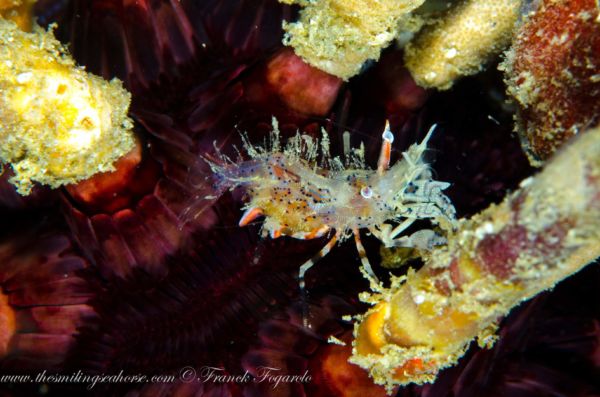 Did those hydroids just move? That’s what I thought the first time I saw this minuscule critter. Hidden among rocks and debris or in crevices, the spiny tiger shrimp prefers to live in the company of at least one other individual or sometimes a small group. Growing to only ¾ inch (2 cm) long, their bodies are covered in spots, stripes and tiny spines that resemble algae or hydroids. As they are so small, they have developed this appearance to blend into their surroundings and avoid getting gobbled up by larger fish.
Did those hydroids just move? That’s what I thought the first time I saw this minuscule critter. Hidden among rocks and debris or in crevices, the spiny tiger shrimp prefers to live in the company of at least one other individual or sometimes a small group. Growing to only ¾ inch (2 cm) long, their bodies are covered in spots, stripes and tiny spines that resemble algae or hydroids. As they are so small, they have developed this appearance to blend into their surroundings and avoid getting gobbled up by larger fish.
AUTHOR CAMILLE FOGAROLO AND HER HUSBAND FRANCK OWN THE MV SMILING SEAHORSE LIVEABOARD, THE NEWEST DIVE BOAT IN THE AREA. ALL IMAGES COURTESY FRANCK FOGAROLO.
Share this:
Camille Fogarolo / About Author
Camille has been traveling the world since her mid twenties and dived many seas before finally settling down in Thailand in 2012. With her husband Franck, they opened The Smiling Seahorse liveaboard to offer cruises in the most unexplored area of South East Asia and became quite the experts when it comes to diving in Myanmar! Proud mother of two she still travels as much as she can and usually joins a dive trip to Mergui Archipelago every month.
On the southwestern coast of mainland Thailand is the picturesque town of Krabi. With beaches, caves, waterfalls, temples, mountains, and hot springs, Krabi has become popular with tourists looking for adventure. Kayaking, rock climbing, hiking, and whitewater rafting are just some of the activities on offer. But the real highlight is the scuba diving in Krabi
Krabi is a great place to base yourself if you want to dive the Phi Phi islands and sites around Koh Lanta and Phuket. But don’t overlook the top-class dive sites that are right on its doorstep. Off the coast of Krabi’s Ao Nang Beach is a group of islands that offers something for everyone. Drop-offs, reefs, wall dives, swim-throughs, and caverns are home to over 200 species of fish and 80 species of coral.
Average depths here are around 66 feet (20 m) so are ideal for beginners. If you’re looking for an underwater adventure, look no further than Krabi. Here are some of the most popular local dives in the region.
Koh Talu
Koh Talu literally means “island you can go through,” and gets its name from two shallow swim-throughs that run right beneath the island. The main tunnel cuts through the entire length of the island and its width means that it’s accessible to most divers.
Large barracuda often hang out at the tunnel entrance. The reef is made up of soft tree, mushroom, and table corals and surrounding the island are numerous pinnacles so there’s plenty to explore. Seahorses, bent-stick pipefish, pufferfish, razorfish, flabellina nudibranches, and sea kraits are just some of the many highlights at Koh Talu.
Koh Ha
Koh Ha is home to over 60 varieties of coral and many gorgonian sea fans. The eastern side is mainly patch staghorn and to the southeast is a wall dropping down to 60 feet (18 m) covered in sea whips and fans. These provide shelter to an amazing array of shrimp, crabs and bamboo sharks that hide beneath rocks. Look in the sand for cuttlefish and stingrays. If you’re diving Koh Ha in the early morning, watch for leopard sharks that tend to laze on the sand.
Koh Yawabon
Koh Yawabon boasts the longest swim-through in the region at 164 feet (50 m). Part way through you can actually surface inside a chamber and pause to appreciate the huge stalactites hanging from the ceiling. The tunnel is only 33 feet deep (10 m) but strong currents and a large no-light zone make it suitable for experienced divers only.
Because of this, many dive shops bypass the site, which makes it popular with large schools of usually shy fish. Koh Yawabon is also a macro photographer’s dream, with divers regularly spotting tiger tail seahorses and as many as 20 different species of nudibranch in a single dive.
Koh Dor
The closest dive site to Krabi is Koh Dor. A good mixture of stony porites, soft coral, sea fans, leather coral, and sea whips cover the reef, and barrel sponges dot the area. You’ll see porcupinefish, dog-faced pufferfish, and trumpetfish, along with sea cucumbers and black spiny sea urchins that cover the sandy bottom.
The real draw at Koh Dor, however, is that it’s the best spot in Krabi to see blacktip reef sharks. These elusive creatures often appear in the afternoon on the western side of the island. Although you may catch a glimpse of one while diving, the best way to observe them is by snorkeling during your lunch break.
Koh Yawasam
Two neighboring rocky islets make up Koh Yawasam. Shallow patches of table and staghorn coral, areas of flat sand, and deeper waters combine to make this an ideal site for training dives. It’s also a popular spot for snorkeling trips from Krabi. The marine life is varied and you’ll see numerous nudibranchs, angelfish, butterflyfish, snapper, barracuda, moray eels, and bamboo sharks. Koh Yawasam is also the best place to see the rare red saddleback anemonefish.
HTMS Ravi
Koh Yawasam is the location of Krabi’s very own wreck. The 120-foot (36 m) long, 33-foot (10 m) wide tank-landing craft, HTMS Ravi, was purpose sunk in April 2013 to create an artificial reef. Today it sits upright at 82 feet (25 m) below the surface and is teeming with marine life for divers of all levels to explore.
Koh Si
Another popular spot with snorkelers and divers is Koh Si with its large coral-covered pinnacles on either side of the island. Visibility is variable but when conditions are right, you’re likely to see large schools of snapper, fusilier, sardines, and big-mouth mackerel. To the north of the island tubastrea corals, sea whips, and barrel sponges cover a steep wall. There’s also small cavern where spiny lobster and banded sea snakes hang out. Scorpionfish, seahorses, nudibranchs, bamboo sharks, filefish, and pipefish hide among the reef. Koh Si is also a good place to get a brief glimpse of blacktip reef sharks.
When to go
Having a tropical climate means Krabi is one of Thailand’s year-round destinations for scuba divers. Water temperatures vary only slightly between 82 and 87 F (28 and 30 degrees C). High season lasts from November to April when the northwest monsoon brings sunny days and light breezes. December and January are the busiest months and accommodation in Krabi during this time becomes expensive — if you can find anything available.
May to October is still pleasant, averaging 20 days of sunshine a month. But the southwest monsoons bring rain and winds, making conditions unpredictable. During this low season, dive shops often cancel trips due to rough seas.
February, March, and April are the months to visit Krabi if you want to avoid crowded dive sites. Accommodation is reasonably priced during this time and you’ll have near-perfect weather and calm seas for your diving adventure.
Share this:
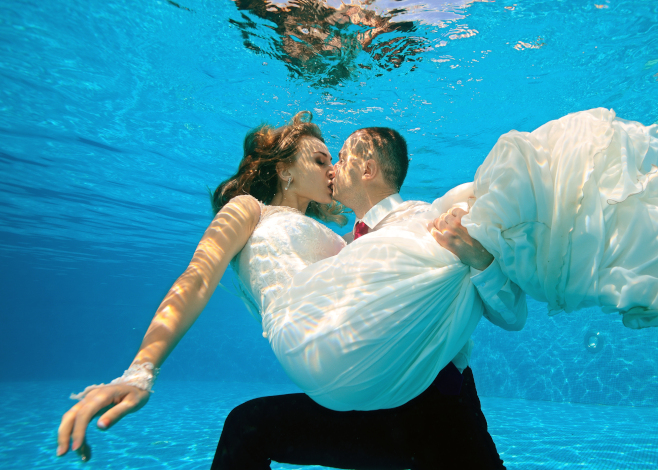
If you and your partner want to get married underwater — with or without a wedding party — there are a variety of places across the globe that can accommodate your deepest wishes. In most cases, you wear a dive mask or a full-face mask with audio communications, a tank with a regulator, BCD, and fins. You’ll kneel on the sandy bottom as the facilitator either shows you a slate to ask you questions or uses basic hand signals so you and your spouse can say, nod, or give a thumbs up for “I do” during a 15- to 20-minute ceremony.
Check with each venue on whether you need a diving certification before the ceremony; most can accommodate you with a resort course. And please note: An underwater wedding is not usually “official,” so you may need a civil ceremony to make it legal, at the destination of your choice or your hometown. With that said, here are some of our favorite places to get married underwater.
Polynesia
Bora Bora Lagoon
Bora Bora is frequently cited as one of the world’s most romantic islands. It’s home to green, craggy mountains spilling to cerulean water, surrounded by a rugged barrier reef, white-sand beaches, and a spectacularly shallow lagoon. You’ll wear underwater helmets for your ceremony, which will take place in a shell-encrusted, A-frame chapel a mere 13 feet (4 m) deep, officiated by a scuba-certified Polynesian master of ceremonies. Wooden cabins built over the ocean with glass-bottom floors, a turtle sanctuary, and great diving or snorkeling are all just steps away.
Bahamas
Paradise Island
One of the largest resorts in the Caribbean is just off Nassau’s shore. If you want to have a “dry” wedding, but with a nautical setting, book your wedding ceremony and party in a room in the center of their spectacular aquarium with over 50,000 animals.
Nassau
Here, your wedding guests can include a bunch of wild Bahamian sharks –– or none –– to surround your ceremony, or opt for a calmer ceremony by a shipwreck, conducted by a non-denominational pastor and licensed marriage officer.
Hawaii
Oahu
One dive operator can accommodate groups from just the bride and groom, up to 30 divers around at sites in the Waikiki and Diamond Head area, whether you’re all certified or not. They’ll even arrange for professional photo and video services to remember your big day.
Maui
On “The Friendly Island,” you can “Get Maui-ed” in the ocean via a shore dive or a boat dive to Molokini Crater. Alternatively, you can enter the aquarium’s 750,000-gallon ocean exhibit and shark tank so your wedding party can watch the ceremony without getting wet.
Cayman Islands
Grand Cayman
Since 1996, couples have been exchanging vows while blowing bubbles near Grand Cayman’s famed Seven Mile Beach, with scuba communication gear that allows them to speak and be heard. With visibility ranging from 100 to 200 feet (33 to 66 meters), after the ceremony there’s plenty of time to enjoy dramatic walls and shallow reefs.
Little Cayman
This small island to the northeast of Grand Cayman is a popular among divers because of the great sites along Bloody Bay Marine Park. With just a few resorts on the island compared to Grand Cayman, you’ll be able to enjoy a very private honeymoon and some incredibly deep drop-offs.
Florida
Key Largo
Key Largo is adjacent to John Pennekamp Coral Reef State Park. Captain Slate, AKA “Justice of the Pisces” has been officiating underwater ceremonies next to the bronze Christ of the Abyss statue here for decades.
Ft. Lauderdale
Ft. Lauderdale offers over 75 dive sites where divers can exchange rings. A reef lies as close as 300 feet (100 meters) from shore and begins at only 20 feet (7 meters), so you can get hitched while blowing bubbles, and even hire a photographer or videographer to capture the ceremony.
Mexico
Riviera Maya
Both Cancun and Cozumel offer warm water and shallow diving along the world’s second largest barrier reef system. You can get married underwater in Spanish, French, Portuguese, or English.
Cabo San Lucas
Though the ocean is typically rough because of strong waves and wind where the Pacific Ocean meets the Sea of Cortez, the bay offers a calm environment for underwater weddings. You can even place your wedding rings into a calm shell that’s yours to keep.
Author Gil Zeimer learned how to dive on Grand Cayman in 1981. He’s been hooked ever since and has explored the underwater world from Australia to Micronesia to Aruba. As a travel writer, journalist, and advertising writer, Gil is passionate about helping diving industry clients promote their sites, resorts, and causes. He lives in Tiburon, California, which is Spanish for “shark.” Find out more about him here or follow him on Facebook.
Coral reefs are some of the world’s most colourful and diverse
ecosystems, and a hidden treasure to feast the eyes upon for any
scuba diver and snorkeller. But why should you wait for a boat trip
from your hotel when you can access these underwater Edens straight
from the shores of your resort? So without further ado, here’s our
top five hotels with the best house reefs.

Azura Quilalea Private Island, Mozambique
Visible from the sky, the Quirimbas Archipelago is a mesmerising
tapestry of colour; a chain of 32 coral islands, thick with
mangroves and encircled by white sand which dissolves into crystal
waters fringed by coral skirts – and one of these islands is the
luxurious Azura
Quilalea Private Island. The protected reefs lining the
island’s shores offer some of the best diving in the world – expect
to see green, hawksbill and leatherback turtles, reef sharks, sting
rays, moray eels and a plethora of colourful reef fish. Depending
on the season, you might also spot humpback whales and whale
sharks. And with only nine individual villas, you’ll have the reef
all to yourself.

Amanwana, Indonesia
Largely uninhabited and unknown to the majority of tourists,
Moyo Island is a
treasure chest waiting to be discovered. The marine park was
established long before tourism reached the area, so divers are in
for a real treat – think corals dating back more than 100 years and
a whole spectrum of fish, from frogfish, lionfish and blue ribbon
eels to white tip sharks and nudibranch the size of dinner plates
(extremely rare).
The only hideaway on Moyo Island, Amanwana is located on a
protected cove in the west. Here, you can stay in luxury tents
encapsulated by lush tropical rainforest. Most significant,
however, is the diving, with one of Moyo’s best dive sites, Panjang
Reef, mere minutes from Amanwana. In fact, the reef is so enticing
you may not spot the bigger pelagics casually gliding past behind
you…

Angsana Ihuru, Maldives
Quite simply the best house reef in the Maldives – over 150 fish
species, turtles, rays and sharks call Angsana Ihuru (the
sister resort to Banyan Tree Vabbinfaru) home. Forming a perfect
circle around the island, you can don your mask and explore these
perfectly preserved reefs straight from the chalk white shores.
Night dives? Sure, experience a different reef as you swim amongst
nocturnal manta rays and snakelike moray eels. Into wrecks? Dive
the Rannamaari shipwreck, conveniently located less than 100 metres
from the beach. Fancy a day trip? Take a boat to sister property
Banyan Tree Vabbinfaru and snorkel a different scene. You can even
plant a coral or two at the resort’s Marine Lab.

Qamea, Fiji
Picture a tropical paradise hideaway and you will have pictured
Qamea.
A place where emerald, jagged volcanic mountains meet shockingly
turquoise waters via sweeping white beaches. Most importantly, a
place where you can snorkel out to some of the world’s best reefs
without breaking a sweat. In fact, there are so many spectacular
dive sites within easy reach of the resort that you’ll be hard
pressed to experience the same topography twice. From a 100ft
vertical wall dripping in sea grapes and hard corals, to
technicolour soft coral gardens (Fiji is the “soft coral capital of
the world” after all), drift dives and swim throughs – not to
mention the whirlpool of marine life to feast your eyes upon.

Wakatobi Dive Resort, Indonesia
About as remote as you can get, Wakatobi Dive Resort
is an adventure in itself to get to; a two and a half hour charter
from Bali followed by a ten minute bus ride and fifteen minute
boat. But it’s worth the pilgrimage – 400 species of coral and 700
species of fish have been officially recorded in Wakatobi alone.
Want to head out on the house reef solo? Get dropped off at the
perfect spot and let the current drift you along the world’s best
aquarium, spotting the most sought after species in abundance
(pygmy seahorses, crocodile fish… the list goes on) before being
conveniently deposited in the shallows to waiting staff to relieve
you of your gear in time for sundowners.
When you set sail on your liveaboard to destinations
unknown, and with a salty ocean breeze ruffling your hair, it’s
hard to argue with the old proverb about the journey being as
important as the destination. As your skipper plots his course
between the most coveted diving destinations, a liveaboard cruise
allow divers unparalleled opportunities to explore some of the
finest dive sites in the world. Whether you board a traditional
phinisi boat or a luxurious floating five-star hotel; whether
you’re a snorkeller or advanced diver; whether you want to up the
dive count or combine diving with land-based escapades, discover
the top five destinations for liveaboard diving.

Liveaboard Diving in Oman
Located off the south eastern coast of Oman, the Hallaniyat Islands are a
relatively new destination for liveaboard divers, wherein lies the
charm. Board the Oman Aggressor
to cruise the archipelago, diving in a fish soup of reef species
alongside honeycomb moray eels, dragon morays, giant groupers, sea
turtles and – if you visit between January and March, humpback
whales – all without another soul in sight.

Liveaboard Diving in the Maldives
Rather than pick one idyllic island paradise in the Maldives, cruise around several aboard
some of the world’s finest luxury liveaboards, dipping into a
different turquoise atoll each day to explore some if the
archipelago’s more remote dive sites, ranging from crystal clear
lagoons to thrilling channel dives. Along the way, dive with manta
rays, sharks, dolphins, groupers and more, spending surface
intervals exploring local islands and picnicking on deserted
sandbanks.

Liveaboard Diving in Micronesia
You might wonder where on earth Micronesia even is –
and that’s precisely the point. Located in the pacific, this remote
archipelago is home to Chuuk
Lagoon, the site of a ferocious airstrike carried out by the
United States on the Japanese in WWII known as ‘Operation
Hailstone’. Only accessible by liveaboard, divers can explore an
underwater museum of over 50 wartime wrecks draped in hard and soft
corals, spotting all manner of cargo including bullets, gas masks
and even bones, a haunting reminder of the lives lost. For the best
of both worlds, hop west to Yap where
diving with mantas is virtually guaranteed year-round in the Mi’l
channel.
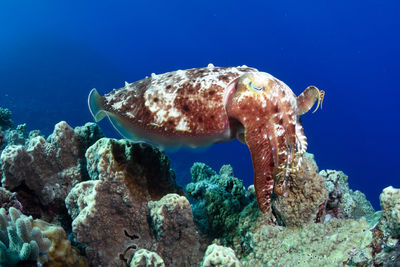
Liveaboard Diving in Australia
The three swirling atolls that make up Rowley Shoals are the
remnants of a trio of extinct volcanoes, featuring everything from
dramatic canyons and lagoons to thrilling drift dives and plunging
wall dives, are populated by healthy corals and abundant marine
life (over 688 species, to be exact). The Rowley Shoals are located
180 miles west of Broome, so set sail aboard True
North and explore sites guided by a marine biologist and posse
of underwater naturalists, naturally. Continuing on the ‘three’s
the magic number’ theme, cruising across western Ningaloo
Reef for whale sharks (winter) or humpbacks (summer) and
exploring the Great
Barrier Reef are also best done by liveaboard. All aboard!

Liveaboard Diving in Indonesia
Whether sailing around the traditional favourites of Raja Ampat and Komodo, or exploring the
lesser known (but no less impressive) corners of Alor or the Banda islands, it’s not
unusual to have entire reefs to yourself. Even better, the
remoteness of these sites and limited human interaction means
everything comes supersized. From table corals that could seat a
dozen for dinner to vast cabbage patches, bulbous brains and
highlighter shaded soft corals, all are blurred with bright
flickers in every colour as fish dart about their daily lives.
Above the surface, sweeping vistas reveal a time seemingly
forgotten, with undisturbed glassy watered bays to misty jungles
exhaling thin clouds of smoke from hidden villages. Slip into a
delicious routine of eat, sleep, dive, repeat as you delve a little
deeper into Indonesia’s mind-boggling marine diversity.
Interested in liveaboard diving?
Get in touch to plan your next liveaboard diving
adventure.
Ever been baffled on how underwater photographers snap the
most minute creatures in such magnificent detail? Perhaps wondered
whether the winners of Wildlife Photographer of the Year were
carefully planned or super lucky (or both!)? Us too, so we
interviewed professional underwater photographer Saeed Rashid for
his top underwater photography tips for beginner
photographers…

1. Keep Your Critters Close
It might sound obvious but one of the best tips for capturing
the perfect shot is to get closer. While this might be easy with
stationary subjects, with timid fish remember to take your time,
watch your surroundings and never poke, prod or harass your subject
to get them closer to your lens. We are guests in their world and
there should be no shortage of subjects on the reef.

2. Behavioural Instincts
Talk to most dive guides and they will tell you that they rarely
look for the subjects themselves but the habitat in which they
live. Some critters, like the ‘Shaun the Sheep’ nudibranch or a
whip coral shrimp, can be so small they appear as a tiny dot but if
you know the type of places to look you can find these amazing
critters. Grab yourself a magnifying glass and keep it in your BCD
pocket as it will significantly aid your search for some of the
smaller subjects in the sea.
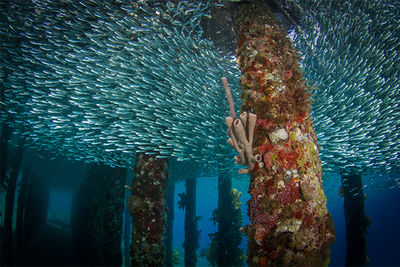
3. A Lightbulb Moment
Artificial lighting – the use of strobes (flashes) and
occasionally continuous lights (torches) – is important for
photographing the smaller fish and critters on the reef. Spend time
practicing in a swimming pool before you get out on the reef and
when you do take a photo check it out on the camera screen, zooming
into the corners just to make sure you have them positioned
correctly. Remember, with lights you can get a big difference with
only a small change so adjust settings a little at a time.
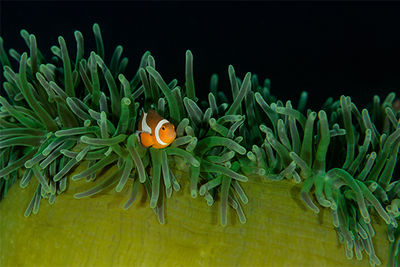
4. Think Composition
Try and make something in your photograph the focal point. This
could be a fan coral on a wall, the eye of a fish or even your
buddy – this will add interest and really help your image ‘pop’.
See if you can add depth to your composition by shooting along a
reef or blurring the background. Many people will tell you to fill
the frame with the subject but a clever use of so-called negative
space can be just as powerful.

5. Never Shoot Down, Except…
When I teach new underwater photographers, I often talk about
getting ‘clean water’ behind your subject. The best way to do this
is to get down below or at least eye level with your subject. For
me, the only time you break this rule is when you’re photographing
something that has an attractive back such as a turtle, shark or
ray.
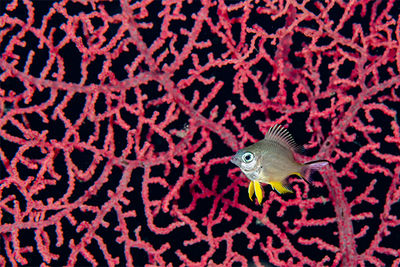
6.A Beautiful Backdrop
Even when you are photographing the most colourful and exciting
subjects a messy background can ruin your photograph. Experienced
photographers often look for background first then search for a
foreground subject to add interest. I will often follow a fish in
my viewfinder and only press the shutter when it ventures to a more
photogenic location.
Want to perfect your photography skills on your next
diving holiday?
Get in touch with one of our team to discover
more.
Interesting Info
 Private Scuba Tuition – Learn Scuba Skills.
Private Scuba Tuition – Learn Scuba Skills.
Joey Ridge offers private scuba diving training for those who would feel more comfortable in a private one to one setting
Diving Services
- Beginner Diving
- Padi Recreational Courses
- Padi Technical Courses
- Professional Instructor Courses
- Dive Equipment Servicing
Contact Me
Contact: Joey Ridge
PADI Course Director
TecRec Instructor Trainer
Tel: +357 99676216
Whatsapp – Facetime – Skype























</p><p> ” data-medium-file=”https://scubadiverlife.com/wp-content/uploads/2020/08/krabi-6-600×450.jpg” data-large-file=”https://scubadiverlife.com/wp-content/uploads/2020/08/krabi-6-1200×900.jpg” src=”https://i0.wp.com/scubadiverlife.com/wp-content/uploads/2020/08/krabi-6-scaled.jpg?w=430&h=323&ssl=1″ width=”430″ height=”323″ data-original-width=”430″ data-original-height=”323″ =”http://schema.org/image” title=”krabi moray” alt=”Most dives feature morays (courtesy of author)”> </a></p><p> Most dives feature morays (courtesy of author)</p></p></div><div
class=)

